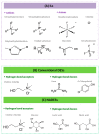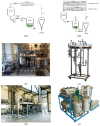Review of Alternative Solvents for Green Extraction of Food and Natural Products: Panorama, Principles, Applications and Prospects
- PMID: 31430982
- PMCID: PMC6721174
- DOI: 10.3390/molecules24163007
Review of Alternative Solvents for Green Extraction of Food and Natural Products: Panorama, Principles, Applications and Prospects
Abstract
In recent years, almost all extraction processes in the perfume, cosmetic, pharmaceutical, food ingredients, nutraceuticals, biofuel and fine chemical industries rely massively on solvents, the majority of which have petroleum origins. The intricate processing steps involved in the industrial extraction cycle makes it increasingly difficult to predict the overall environmental impact; despite the tremendous energy consumption and the substantial usage of solvents, often the yields are indicated in decimals. The ideal alternative solvents suitable for green extraction should have high solvency, high flash points with low toxicity and low environmental impacts, be easily biodegradable, obtained from renewable (non-petrochemical) resources at a reasonable price and should be easy to recycle without any deleterious effect to the environment. Finding the perfect solvent that meets all the aforementioned requirements is a challenging task, thus the decision for the optimum solvent will always be a compromise depending on the process, the plant and the target molecules. The objective of this comprehensive review is to furnish a vivid picture of current knowledge on alternative, green solvents used in laboratories and industries alike for the extraction of natural products focusing on original methods, innovation, protocols, and development of safe products.
Keywords: NADES; alternative solvents; bio-based solvent; compressed gas; green extraction; intensification; ionic liquids; solvent-free; supercritical solvent; water.
Conflict of interest statement
The authors declare no conflict of interest.
Figures






References
-
- Kerton F.M., Mariotte R. Alternative Solvents for Green Chemistry. 2nd ed. Royal Society of Chemistry; Croydon, UK: 2013. pp. 1–325.
-
- Henderson R.K., Jimenez-Gonzalez C., Constable D.J.C., Alston S.A., Inglis G.G.A., Fisher G., Sherwood J., Binks S.P., Curzons A.D. Expanding GSK’s solvent selection guide—Embedding sustainability into solvent selection starting at medicinal chemistry. Green Chem. 2011;13:854–862. doi: 10.1039/c0gc00918k. - DOI
-
- Alfonsi K., Colberg J., Dunn P.J., Fevig T., Jennings S., Johnson T.S., Kleine H.P., Knight C., Nagy M.A., Perry D.A., et al. Tools to influence a medicinal chemistry and research chemistry based organisation. Green Chem. 2008;10:31–36. doi: 10.1039/B711717E. - DOI
-
- Prat D., Pardigon O., Flemming H.W., Letetsu S., Ducandas V., Isnard P., Guntrum E., Senac T., Cruciani P., Hosek P. Sanofi’s Solvent Selection Guide: A Step Toward More Sustainable Processes. Org. Process Res. Dev. 2013;17:1517–1525. doi: 10.1021/op4002565. - DOI
Publication types
MeSH terms
Substances
LinkOut - more resources
Full Text Sources

